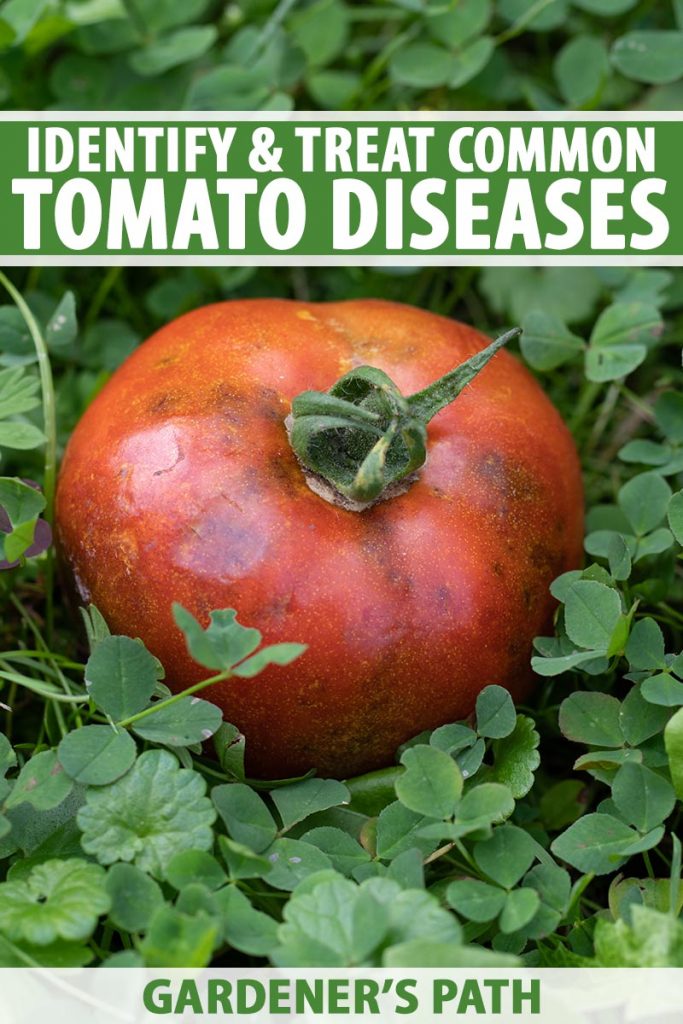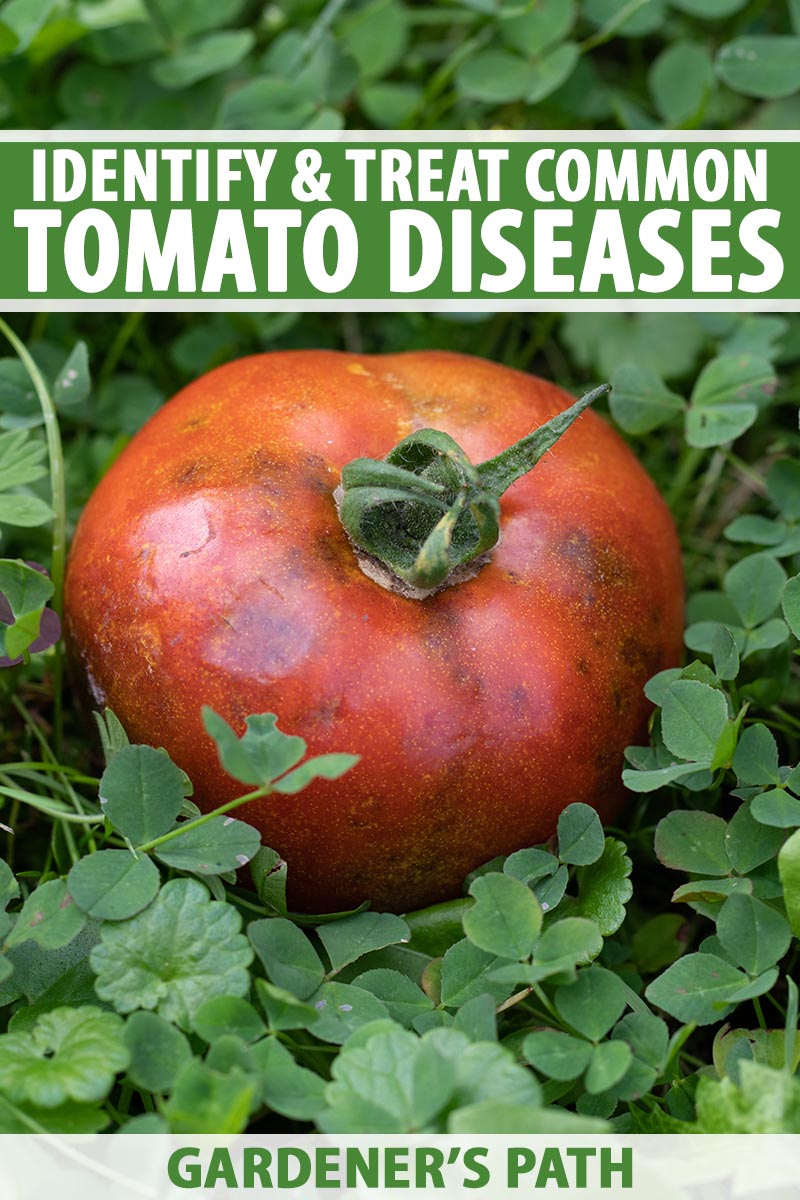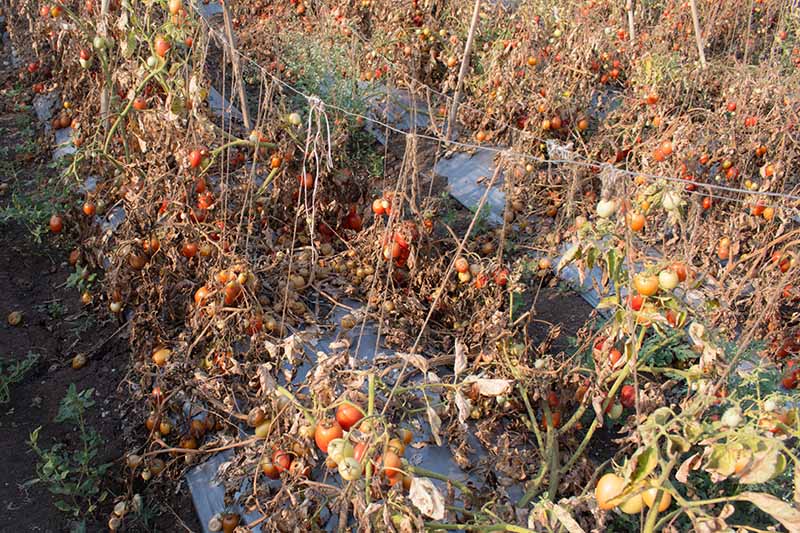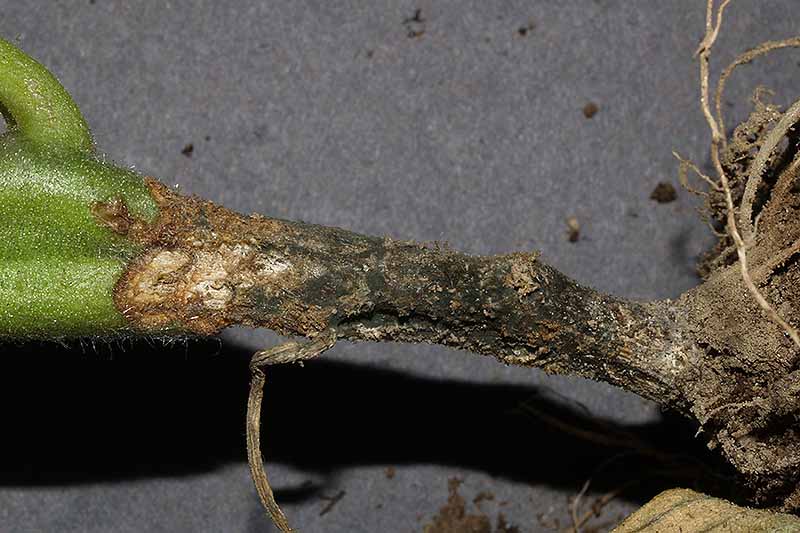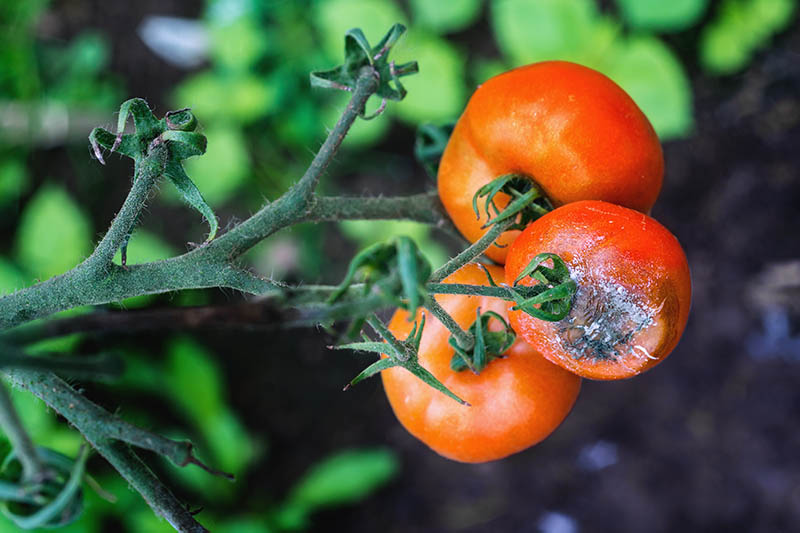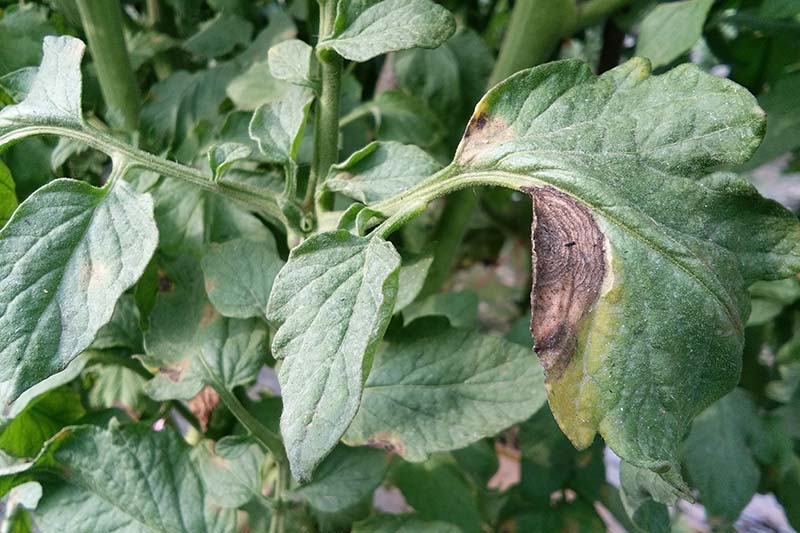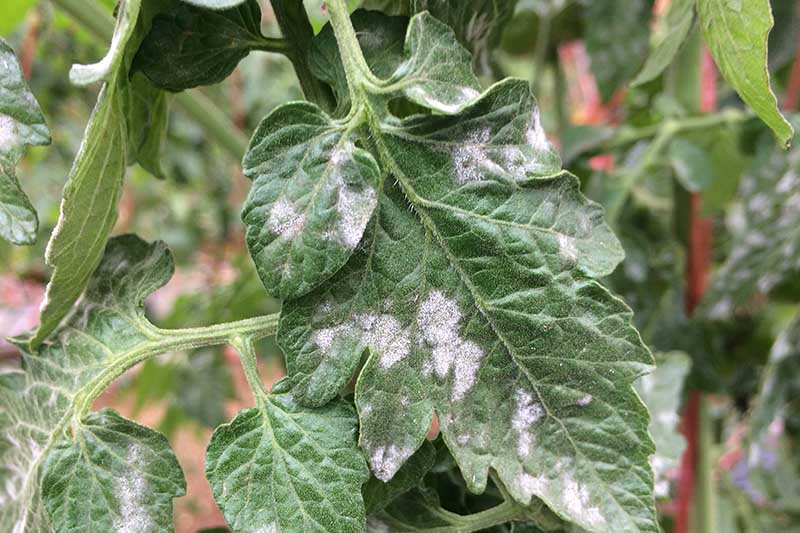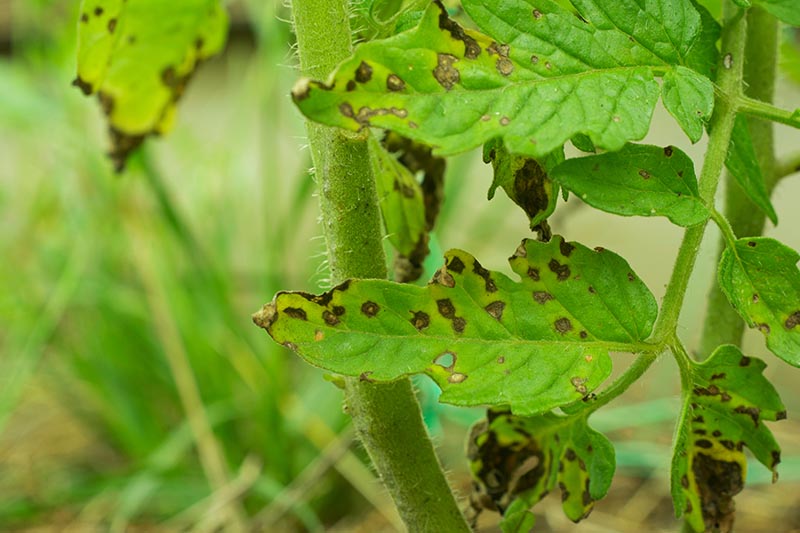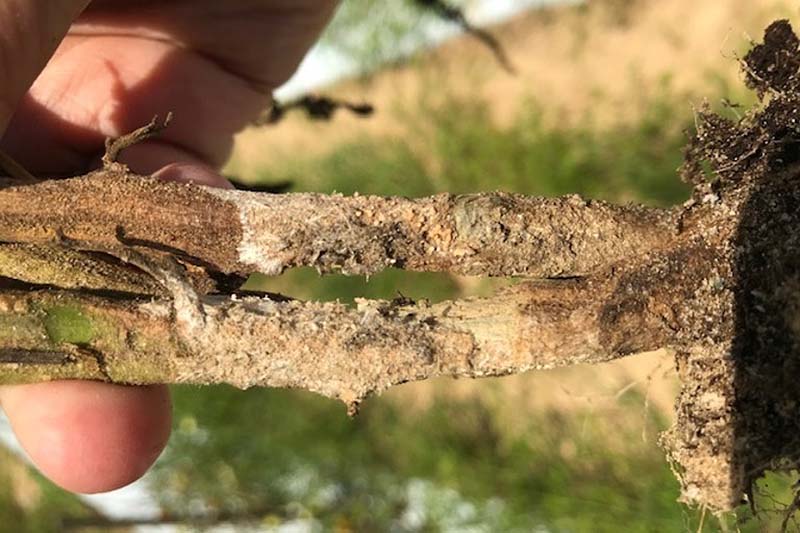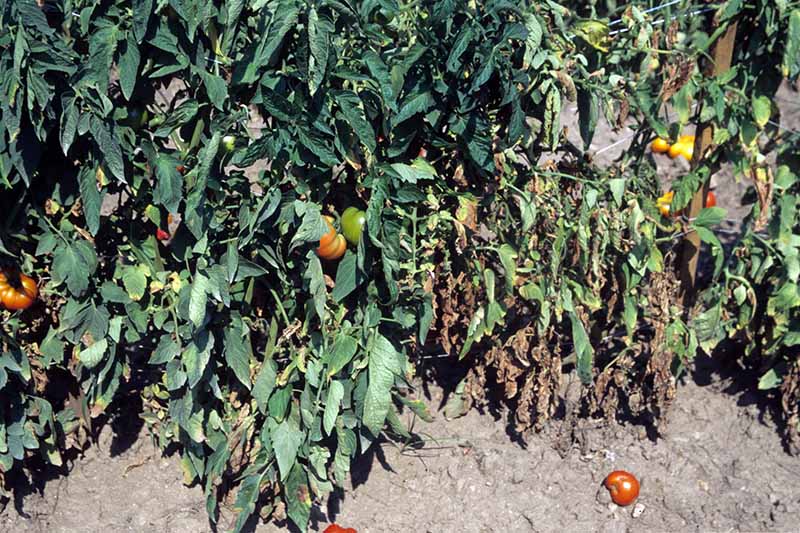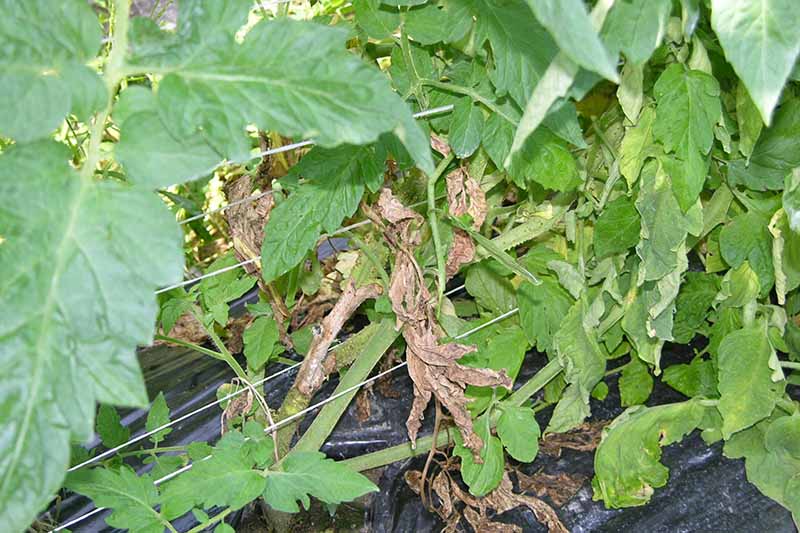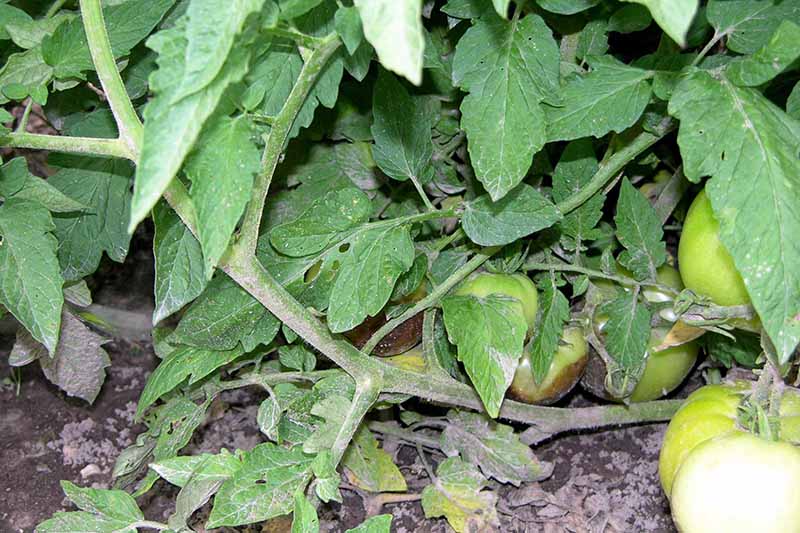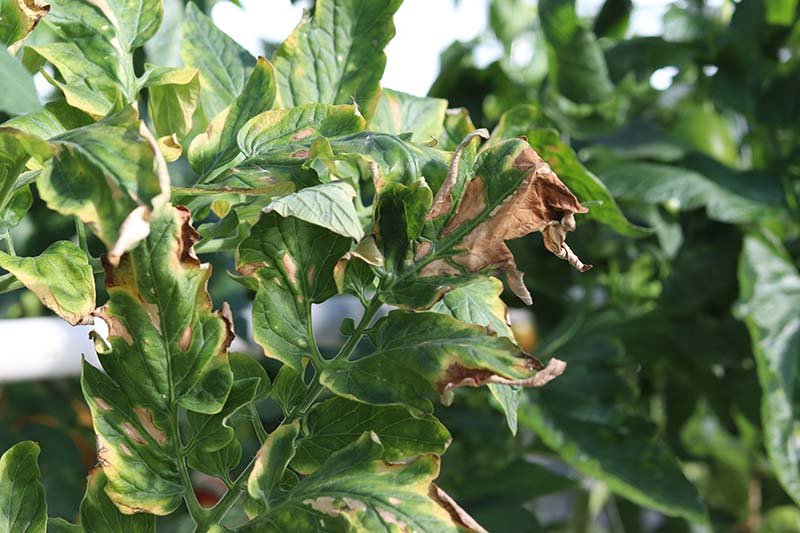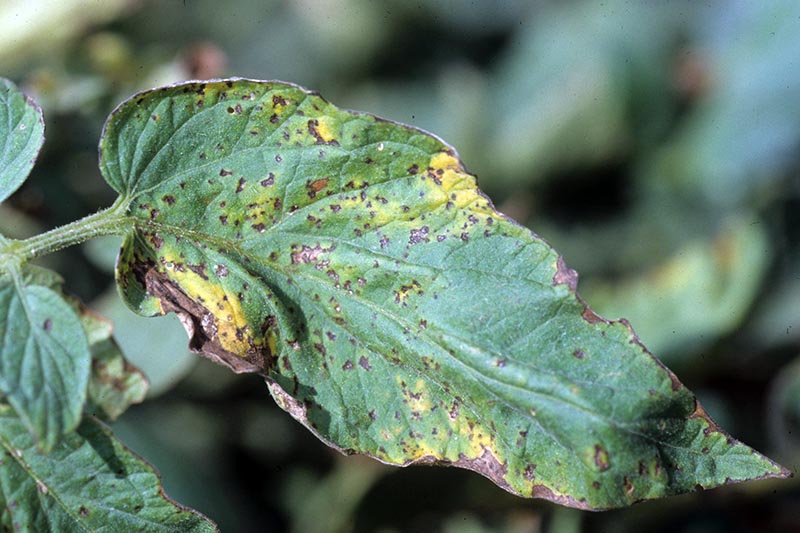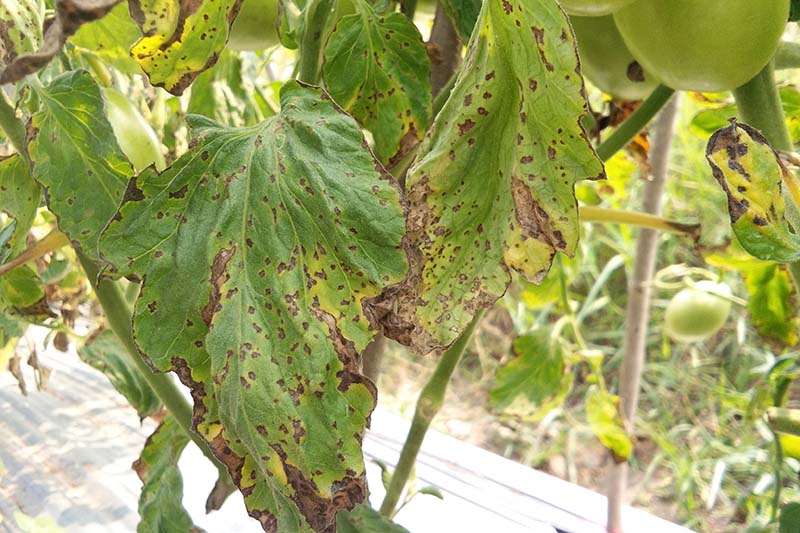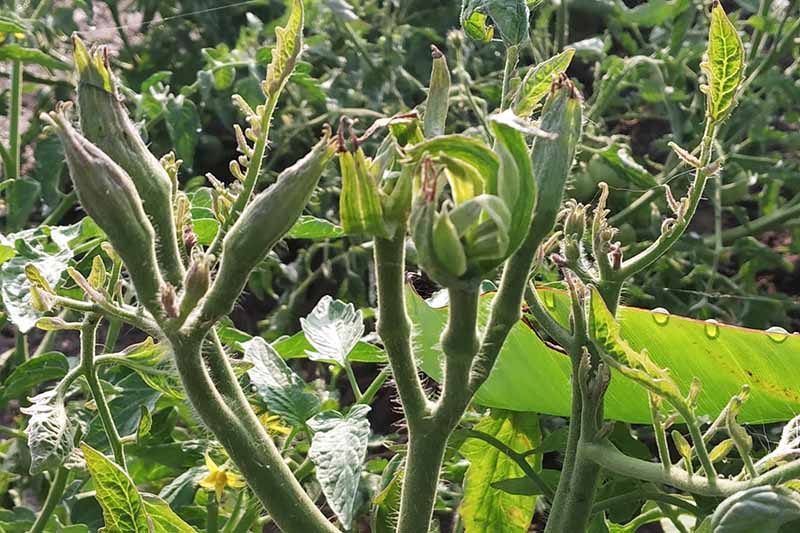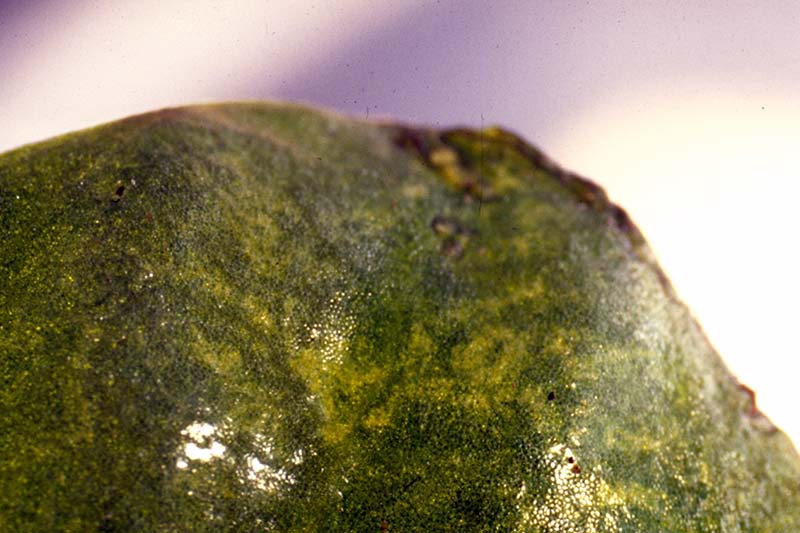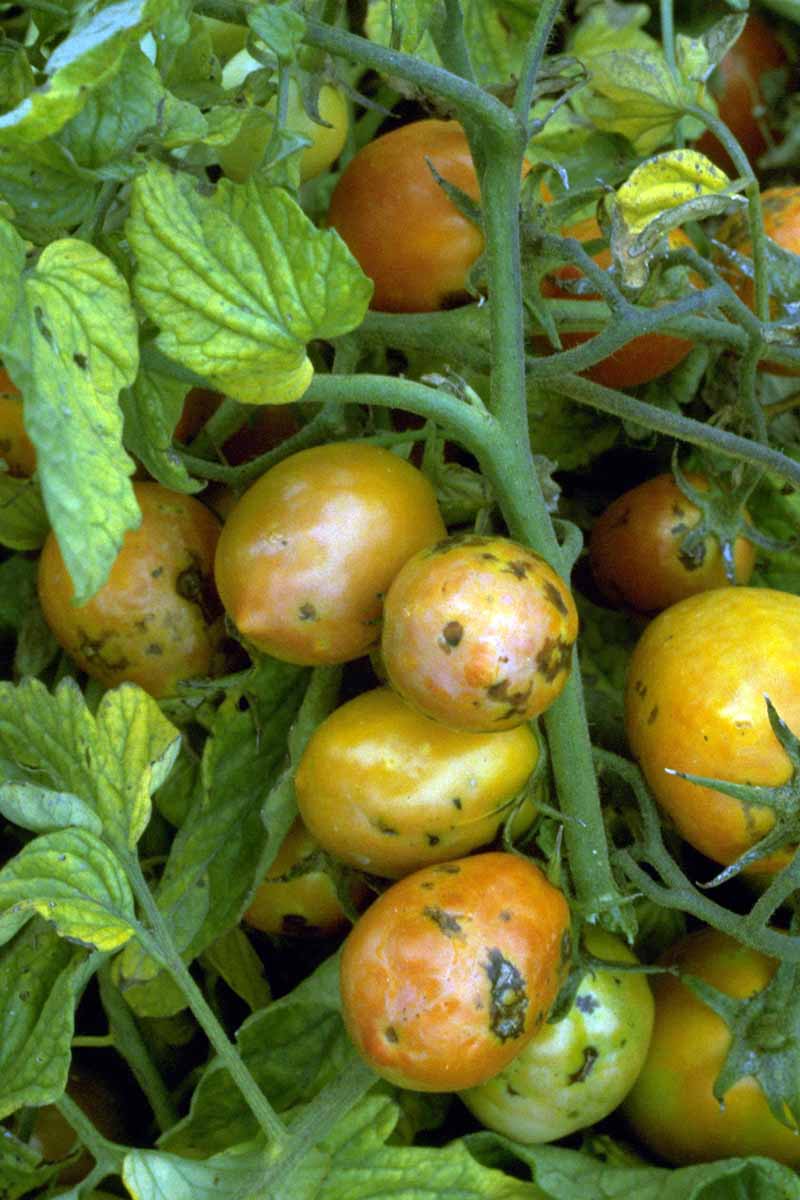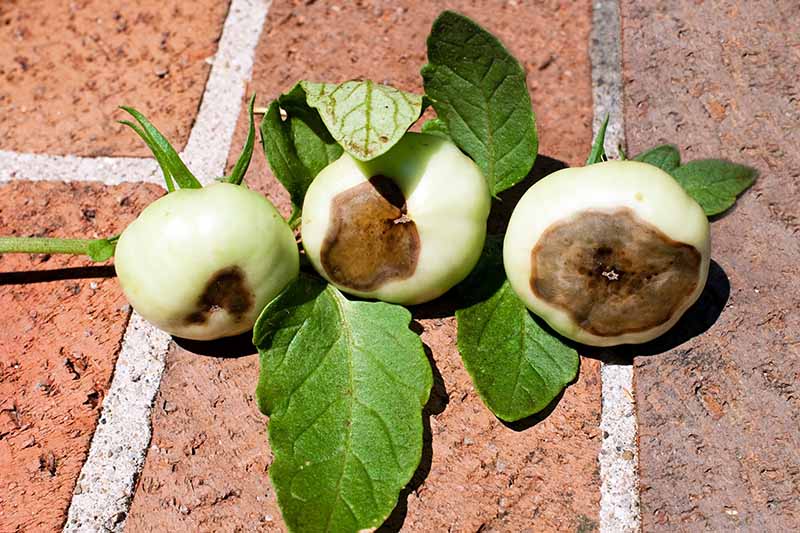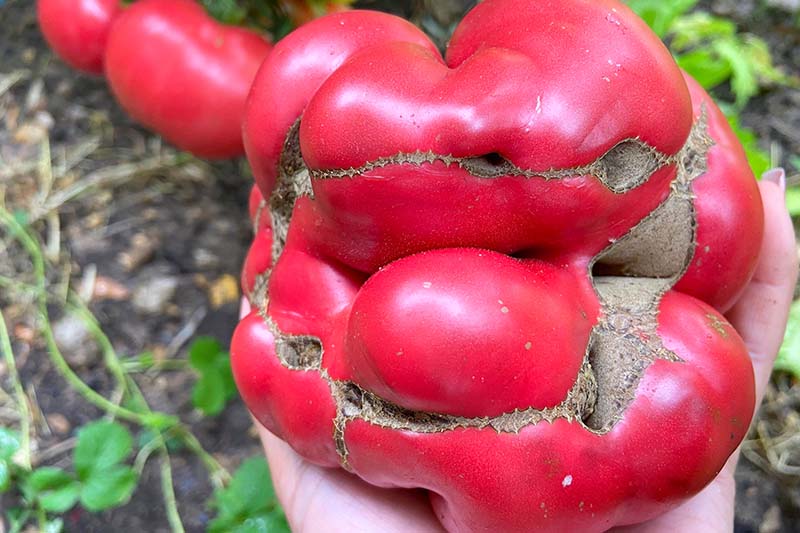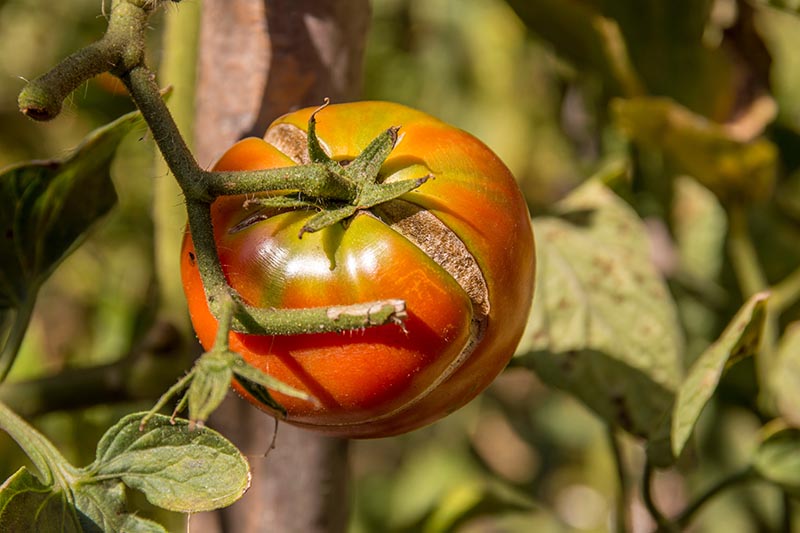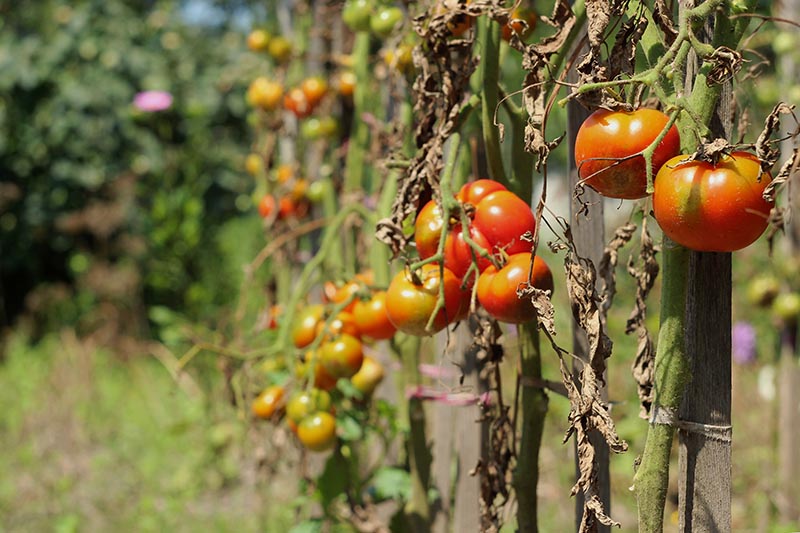So, what’s a gardener to do? Our guide to the most common tomato diseases will help you to identify, treat, and even prevent a variety of fungal, bacterial, and viral ailments, as well as physiological disorders and issues caused by other types of pathogens. We link to vendors to help you find relevant products. If you buy from one of our links, we may earn a commission. If you discover a problem, all is not lost! You may still be able to bring in a delicious harvest. By checking your plants regularly and taking action at the first sign of a problem, many of the diseases and other issues discussed here are treatable, if not curable.
Others may be fatal, but removing diseased plants from the garden is an important step, to avoid further spread throughout the garden. We offer suggested treatments, as well as steps you can take to prevent the same issues in subsequent growing seasons.
Caused by Fungal Pathogens
As is the case with many plants, a wide array of fungi may attack tomato plants. No part of the plant is safe – the roots, stems, leaves, flowers, or fruit, both green and ripe, can all be infected by a number of different types of fungi.
1. Alternaria Stem Canker
Caused by Alternaria alternata f. sp. lycopersici, this fungus is closely related to the one that causes early blight, but in addition to attacking the leaves and fruit, it also commonly causes disease on the stems. The main symptoms are cankers – dark brown recessed lesions – on the stems near the soil line, often with concentric rings. The fungus produces a toxin that causes the tissue between the leaf veins to die and turn dark brown or black. Another symptom is concentric rings on green fruit – either when they are still on the plant, or after an early harvest. The disease is spread by airborne spores, or when infected soil touches the plants. Overhead irrigation, dew, and rain all contribute to its spread. Be sure to always water plants at the soil line to avoid sprinkling the leaves, or use drip irrigation or a soaker hose. Water in the morning rather than at night, so excess moisture has time to evaporate in the heat of the day. Symptoms develop the most quickly when temperatures are above 77°F. A number of resistant cultivars are available, including ‘Phoenix’ and ‘Mariana.’ Another application may be required if you will be harvesting your tomatoes in the fall. A fungicide available to home gardeners that is known to be effective against this disease is chlorothalonil, available from Tractor Supply as Bonide Fung-onil Concentrate. You should apply the fungicide four to six weeks before you expect to harvest your tomatoes, so be sure to check the maturation rates for the cultivars you have planted.
2. Anthracnose
Anthracnose is a very common disease that can infect the leaves, fruit, and flowers of a large variety of plants. In tomatoes, it primarily infects fruit on the vine that are ripe or overripe.
This disease is such a serious problem in processed tomato products that commercial processors adhere to a strict limit on how many lesions a tomato can have. The fungus Colletotrichum coccodes easily colonizes lower leaves that are damaged from early blight or flea beetle infestations, and produces spores that spread to the fruit. The primary symptoms are small, slightly sunken, circular lesions on the fruit. They start out about half an inch in diameter and turn tan. Small black specks become visible in the lesions. If the weather is moist, large numbers of salmon-colored spores can form on the surface of the lesions. Infections on the roots are known as black dot root rot. They become noticeable when the fruit starts to ripen, and can completely rot the cortex of the roots. Anthracnose is primarily a problem when the plant is wet so you should avoid overhead irrigation, particularly when the fruit start to ripen. As with many other tomato diseases, rotate with crops that are not in the Solanaceae family (i.e. potatoes, eggplants, and peppers) at least every other year to prevent spread. Another way to prevent anthracnose is to plant your tomatoes in well-drained soil. The need for fungicides to control anthracnose varies depending on where you are located. For example, in a drier climate like that of parts of southern California, you will probably not need to use them. However, if you are gardening in a place with a humid climate like that of New York State, fungicide applications are recommended. You can use the same fungicides that are effective against Alternaria stem canker for treatment. Read our full guide to anthracnose in tomatoes here. (coming soon!)
3. Black Mold
Black mold can be a serious disease of ripe tomatoes on the vine. It tends to strike following late-season rain.
The first sign of this fungal infection, caused by Alternaria alternata, is lesions on the surface of the fruit. They can range in size from tiny flecks to large, circular, sunken lesions that cause decay deep into the fruit. If the weather is warm and humid, the fungus may produce spores from the lesions that look like black velvet on their surface. The fungus can also invade wounds, including any in areas of the tomatoes that are sunburned. If black mold tends to be a problem in your garden, start harvesting the fruit as soon as they ripen and avoid overhead irrigation, particularly late in the season. Treatment with fungicides may be necessary in rainy years, if the fruit is damaged, or if the tomatoes are being grown for a late harvest. If your plants have the misfortune to be infected, fungicides that control Alternaria stem canker (described above) are also effective against this type of fungus.
4. Botrytis Gray Mold
Gray mold, aka Botrytis blight, is caused by a very aggressive pathogen that can attack over 200 types of plants, including fruit, vegetables, and ornamental plants.
Botrytis cinerea, the species of fungus that causes this disease, is one of the main causes of the postharvest rot of tomatoes that are available for sale. It can also infect plant stems, leaves, and flowers, and it can be a severe problem in greenhouses. This pathogen is widespread on crops and weeds, and the spores are easily spread by wind. Botrytis gray mold tends to occur when there is moisture on the plant, such as from irrigation, fog, dew, or rain. The most typical symptom is a gray mold that covers the flowers. The fruit are usually infected when they are small and green, and white circular spots appear on the tomatoes and turn yellow as the fruit ripens. Avoid overhead irrigation where possible, always sanitize gardening tools, and maintain adequate air circulation between plants to help keep this disease under control. Fungicides can be used to treat severe infections. However, this fungus very rapidly develops resistance. If you need to use fungicides, you should check with your county extension person to see which chemicals work best in your area. Read more about gray mold in tomatoes in our complete guide. (coming soon!)
5. Early Blight
This common fungal disease, caused by Alternaria solani, results in small brown or black spots on the leaves, stems, and fruit. The spots on the leaves and fruit often have a classic pattern of concentric rings.
Early blight is primarily a problem when the weather is rainy. The spores can be splashed onto plants by water, or they may be airborne. The fungus survives on tissue from infected tomatoes, nightshade weeds, and potatoes. Destroying these potential hosts is one way to minimize the chance of infection. Do not add diseased plant parts to your compost pile. You may need to apply a fungicide if an infection is severe. However, the infection may subside if the weather turns dry. Get all the details on early blight in tomatoes here.
6. Fusarium Wilt
Fusarium oxysporum f. sp. lycopersici, a type of fungus, produces spores that can live in the soil for many years, and it can cause a devastating wilt on tomato plants. Infected leaves become yellow and – you guessed it – they wilt. Sometimes, only one side of the plant is affected, causing a characteristic “yellow flag effect.” Plants that are infected usually die. It can be difficult to diagnose whether wilt on tomato plants is caused by Fusarium or Verticillium fungi. A lab diagnosis may be required for a definitive answer. Of course, this option isn’t always readily available to home gardeners. The best way to prevent this disease is by growing resistant varieties, such as ‘Beefmaster’ and ‘Better Boy.’ Keep in mind, however, that choosing a resistant cultivar can be complicated, since there are several races of this pathogen. You will need to choose a variety that is resistant to the predominant race in your area. It is also important to control root-knot nematodes, since they often damage tomato roots so severely that this can destroy any genetic resistance to the disease.
7. Fusarium Crown and Root Rot
As is the case with Fusarium wilt, Fusarium oxysporum f. sp. radicis-lycopersici produces spores that can live in the soil for many years. This is a cool-weather disease that can infect a variety of crops and weeds, including cucurbits, other plants in the Solanaceae family, and some legumes. Waterlogged soil and temperatures between 50-70°F are ideal conditions for an infection to develop. Symptoms manifest on the oldest leaves, which may turn yellow along their margins and then die, and a lesion of dead tissue may be visible on the stems. But this type of Fusarium usually affects the roots, which develop dry brown lesions. This is a severe disease, causing younger plants to be wilted and stunted, and potentially killing mature plants. Effective controls for this disease are limited. Select disease-free transplants for your garden, and if you are growing your tomatoes in a greenhouse, you can steam the soil to sterilize it before planting. In the case of an infection, pull up and dispose of all parts of the diseased plant, including the roots.
8. Powdery Mildew
As its name suggests, powdery mildew spores on leaves make them look white on the upper or lower surfaces. You might also notice spots of dead tissue on the lower leaves, which may be surrounded by a yellow halo.
Oidiopsis taurica fungi do not infect the stems and fruit – so that’s a relief! Spores are usually common in areas near farms and fields, since the fungus commonly infects crops and weeds in the Solanaceae family. The wind carries these spores to tomato plants in home gardens. This disease is usually a problem late in the season and in humid conditions, with temperatures between 60-77°F. Severe infections may be treated with fungicides, or the biofungicide Bacillus pumilus, and some types of organic sprays, such as neem oil, can also be used.
9. Septoria Leaf Spot
Septoria leaf spot, aka leaf canker, is caused by the fungus, Septoria lycopersici. In addition to infecting tomatoes, it can infect other solanaceous plants as well.
Tomatoes can often be infected with leaf spot and early blight simultaneously. This disease first manifests as small, circular spots that appear to be water-soaked. The spots enlarge and often merge to form blotches. Septoria produces small, dark, pimple-like structures in the center of the spots. These are fruiting structures that produce spores. Observing these is one way to distinguish a Septoria leaf spot infection from early blight, which does not produce such structures. These spores are easily spread by wind, rain, clothing, insects, and cultivation tools or equipment. Be sure to always clean and sanitize your gardening gear, between plants and between uses. The fungus can overwinter on the debris of diseased plants, and weeds like nightshade, jimsonweed, or ground cherry. Control measures typically involve eliminating sources of spores. Be sure to always do a thorough job of cleaning up the garden at the end of the season, and dispose of any debris that may be infected in the trash. You can apply fungicides if an infection is severe. Read more about Septoria here.
10. Southern Blight
Southern blight is a disease that is prevalent in high temperatures – above 85°F. Sclerotium rolfsii fungi can survive in the soil for very long periods, because it produces resting structures called sclerotia. To make things worse, Southern blight attacks a wide range of plants, so it is very common to have sclerotia lurking in the soil. The symptoms of Southern blight start with lesions near the soil line that spread higher up the stem. These lesions girdle the stem and cause the affected plant to wilt. This is followed by white mats of fungal threads that develop on the stem and the nearby soil. A notable characteristic of this disease is tiny tan to brown sclerotia that are produced on the mat. Management techniques include rotating to non-host crops, such as rice, sorghum, corn, or small grains, for at least two years. Pull up and dispose of the infected plants. Also, keeping the surface of the soil dry can help to reduce instances of infection. Learn more about Southern blight in this guide.
11. Verticillium Wilt
This disease may be caused by Verticillium dahlia and V. albo-atrum. These fungal pathogens are next to impossible to get rid of, since they may infect a wide range of plants and can persist in the soil indefinitely. This is because they produce resting structures called microsclerotia, and the fungi can multiply in a number of common weeds. Despite the name of this disease, infected tomato plants do not always wilt. Symptoms start with older leaves that develop yellow, V-shaped areas. The leaf then turns brown and dies. The loss of these leaves typically results in sunscald on the fruit. Symptoms are the most obvious during later stages of infection. Infected plants do not typically die, but yields are generally reduced. It can be difficult to distinguish Verticillium from Fusarium wilt, and doing this definitively may require a lab diagnosis. Management techniques include sanitizing tools and equipment between plants, and rotating crops. Water-saturated soil enhances susceptibility to these pathogens, so be sure to plant in a location with good drainage. There are multiple races of the pathogens that cause this disease, and cultivars are available that are resistant to one race, but not another. Conduct any necessary research to determine what type is prevalent in your area, and look for cultivars with “VF” after their name or in the plant description – this indicates resistance to both Verticillium and Fusarium wilt. Read more about Verticillium wilt. (coming soon!)
12. White Mold (Timber Rot)
White mold isn’t that common, but it can be a severe disease when it does occur. The fungi that cause it (Sclerotinia spp.) often attack decaying flowers that have fallen and lodged on stems. Symptoms start with lesions that appear water-soaked that spread along the stems, which then dry out and look bleached – hence the alternate name for this disease, timber rot. Also known as Sclerotinia stem rot, the most common pathogen to cause this disease is called S. sclerotiorum, which refers to the resting structures known as sclerotia that can abound in the soil. In moist, cool conditions, the sclerotia can germinate to form fruiting bodies that produce millions of spores that are spread by the wind. Unfortunately, simply practicing good sanitation around your tomato plants will not help to control white mold, because of the large volume of spores that are produced. One way of preventing this disease is to avoid the repeated wetting and drying of the surface of the soil by using subsurface drip irrigation. The sclerotia are much less likely to germinate if the surface of the soil remains dry. Read more about this disease here.
Caused by Water Molds
Formerly classified as types of fungi, water molds have been reclassified in their own class – the Oomycetes. They include some of the most devastating plant pathogens known today.
13. Late Blight
The water mold Phytophthora infestans can cause severe infections on tomatoes and potatoes. This is the organism that was responsible for the Irish potato famine, resulting in the death or emigration of millions of people.
The first symptoms are areas of the leaves that appear water-soaked. They rapidly enlarge to form oily purple blotches. Rings of grayish-white mycelia may appear on the lower sides of the leaves. The entire leaf can die, and the disease can spread to the young stems and petioles. The fruit is usually infected on the shoulders, because the spores fall from above. These fruits turn brown, but they stay firm unless other organisms infect them as well. The spores easily spread to other plants, so you should act quickly if your tomato plants have this infection. Not only are your plants at stake, those growing in your neighbors’ gardens are as well. Infection can occur in just 10 hours at high humidity (above 90 percent) with temperatures of 60-78°F. This organism overwinters in the debris of tomato, potato, and other nightshade plants. You should ruthlessly cull any infected plants and remove them from your property. Just to be safe, you should also remove any plants nearby that could be infected, even if they are not showing symptoms. Read more about identifying and controlling late blight.
14. Phytophthora Root Rot/Buckeye
This disease may be caused by Phytophthora parasitica and P. capsici. Since these soil-borne pathogens are water molds, they may infect plants at any stage of growth when the soil is moist. Symptoms include the death of many or nearly all of the roots. The plants respond by wilting or dying – particularly in hot weather. In seedlings, this disease is one of several that can cause damping off. Keeping soil moisture constant and avoiding broad fluctuations can help to control this disease, as does providing good drainage and preventing flooding. When these organisms infect the fruit, this disease is called buckeye rot and it manifests as leathery tan or brown spots. Keeping the surface of the soil dry can help minimize the likelihood of damage to the tomatoes. The use of cereals as a rotation crop may help reduce the levels of these pathogens in the soil. In extreme cases, the use of fungicides may be necessary.
Caused by Bacterial Pathogens
Bacterial diseases of tomatoes can be highly destructive to plants grown outside as well as those grown in greenhouses. Usually introduced by infected seed or transplants, bacteria can reproduce rapidly and can be spread via water, gardening tools, and insects. Keeping your garden free from insect pests and regularly sanitizing your tools can slow the spread.
15. Bacterial Canker
This bacterial disease, caused by Clavibacter michagensis subsp. michiganesis, is a particular problem in greenhouses and can result in total crop loss. It can also cause enormous losses in commercial fields and home gardens during wet weather.
Infected seed is a common source of this bacterium, which can lead to infected transplants. Even certified disease-free seed can harbor the bacteria, or become infected after germination. Bacterial canker can infect plants at all stages of growth. There are two types of infections. The most severe is a systemic infection, in which the bacteria spread throughout the plant. In this case, plants grow poorly and they may wilt. New growth on the most mature branches are the first to be affected. The leaves curl, turn yellow, wilt, turn brown, and then collapse. The stems may develop light streaks that gradually turn dark. In the case of secondary infections, the bacteria infect the surface of the leaves, stems, and fruit. This causes spotting of the leaves and sometimes the fruit. The symptoms observed on the fruit are referred to as “bird’s eye spots,” with raised lesions that are surrounded by a white halo. Bacterial canker is easily spread in wet weather, and gardening in damp conditions can spread the infection throughout the garden. Since this disease is extremely difficult to control, planting disease-free transplants is a key step to avoid infection. R. M. Davis et al. of the University of California advise soaking seeds in 130°F water for 25 minutes before planting to eliminate the pathogen. Greenhouses that will be used to grow tomatoes should be thoroughly disinfected between crops. The bacteria can survive in greenhouse structures and equipment for up to 10 months. Infected plants should be treated with a bactericide during periods of wet weather. Copper is frequently used to control bacterial infections, but it is often not effective with this disease because it doesn’t treat systemic infections. It may be effective in the case of secondary infections. Unfortunately, the bacteria can survive indefinitely in tomato debris. However, if the tissue decomposes in the ground, the bacteria will die. They cannot survive in the soil. Therefore, it is critical for you to remove all affected tomato plants and debris from your property at the end of the season. It’s strongly advised to avoid planting tomatoes or other nightshades for at least one year if your garden has been infected.
16. Bacterial Speck
This is a cool-weather disease, and its progress will stop in hot weather, when temperatures rise above 75°F. Unfortunately, the Pseudomonas syringae pv. tomato bacteria that cause it can survive in the soil. Debris from diseased plants can harbor the bacteria, and it can live on the surface of seeds, too. Symptoms include dark brown to black lesions on the fruit, leaves, and stems. The tissue next to the lesions turns chlorotic and results in the appearance of a yellow halo. Fortunately, this disease can be controlled via cultural methods and use of copper sprays. If you were using overhead irrigation, switch to a soaker hose or water at soil level if your plants develop this disease. Wait to plant in the spring until the weather warms up, and do not plant in a location that harbored the disease the previous year. Rotate to a crop like corn that is not susceptible. Some races of this bacterium have developed resistance to copper and you may need to combine it with another fungicide. You can contact your local extension office to determine which products are effective in your area.
17. Bacterial Spot
An infection by Xanthomonas campestris pv. vesicatoria bacteria causes spots on mature plants and seedlings. Bacterial spot looks similar to bacterial speck, and is often misdiagnosed.
Bacterial spot persists from one season to the next on volunteer tomatoes, weeds such as ground cherry and other nightshades, and in crop debris. This disease frequently spreads via infected seeds. Once the bacteria infect a garden or field, they can be difficult to control. Seedlings that are attacked can lose their leaves. Mature plants usually show symptoms on the older leaves. The disease manifests as areas of the foliage that appear to be water-soaked. The plants can develop large blotches, especially on the leaf margins. Preventative sprays of copper and cultural controls may be used to manage the spread of the disease. Don’t irrigate with sprinklers, since the bacteria can be splashed onto other plants. And be sure to select seeds and transplants that are certified to be free of the disease if this has been a problem for you in the past. Some strains can also infect peppers. Rotating your tomatoes with crops that are not in the Solanaceae family will help to prevent subsequent infection by bacterial spot.
Caused by Phytoplasma
Phytoplasma microbes are smaller than bacteria, and often act like viruses. They are parasitic and require a live host in order to survive.
18. Tomato Big Bud
This disease has a very distinctive symptom: large, swollen green buds that do not produce fruit. Infected plants also appear bushy and have distorted leaves that are a yellow-green color. Tomato big bud (Candidatus Phytoplasma aurantifolia) is transmitted by the beet leafhopper (Circulifer tenellus). The prevalence of these insects in your garden will greatly affect the likelihood of your tomatoes contracting this disease. Read more about how to identify, treat, and prevent big bud in this guide.
Caused by Viral Pathogens
Tomato plants can be infected with a variety of highly damaging viruses. Viral infections typically cause changes to the color of the foliage and can result in stunted or abnormal growth. Viruses are often transmitted by insect pests, another good reason to keep your garden free from infestations.
19. Alfalfa Mosaic Virus
This disease is generally fatal, and it primarily affects tomato plants that are grown near alfalfa. Most commercial alfalfa fields in the US are infected with this virus, and aphids easily transmit the disease to nearby tomato plants. Typical symptoms include leaves that are yellow with some mottling on them, and fruit with circular rings of dead tissue. The phloem in the vascular system – tissue responsible for transporting plant nutrients – also dies and turns brown. There are no chemical controls for this infection, and using insecticides to control the aphids does not help to manage this virus. One management strategy is to put silver reflective polyethylene mulches on the planting beds before planting to repel the aphids. Your best bet to avoid this disease is to avoid planting tomatoes near alfalfa.
20. Tobacco Mosaic Virus
Known as TMV for short, tobacco mosaic virus is amazingly persistent. It has been found to survive for as long as 100 years in dried plant debris. This virus is easily transmitted mechanically – even from tobacco products! It can cause major losses in home gardens, fields, and greenhouses. Symptoms can vary greatly, depending on the cultivar and the TMV strain. A mild mosaic pattern on the leaves is typical. Leaves will be malformed and they may start to resemble ferns. Patterns of dead tissue can develop on the fruit. This disease is common in transplants and fresh tomatoes sold at the market. Avoid throwing store-bought tomatoes on the compost pile, as volunteers can pop up and introduce the virus to your garden. The best way to avoid this disease is to purchase seed that has been treated to eliminate seed-borne sources of infection, and sterilize all gardening tools and equipment. Resistant cultivars such as ‘Arbason,’ ‘Estiva,’ and ‘Geronimo’ are available.
21. Tomato Spotted Wilt Virus
Tomato spotted wilt virus (TSWV) is unique among plant viruses. No other virus has such a wide host range, which includes vegetables as well as ornamentals. The disease caused by this virus used to be confined primarily to tropical areas like Hawaii, but now it is a threat worldwide. This virus causes young leaves to turn bronze, which then go on to develop spots of dead tissue. Ripe tomatoes can turn blotchy with yellowish spots that may exhibit concentric rings. The tomatoes are usually still edible. Tomato spotted wilt is unusual in that it is spread by little insects called thrips, particularly Western flower thrips (Frankliniella occidentalis), as well as onion thrips (Thrips tabaci) and chili thrips (Scirtothrips dorsalis). It is very difficult to control thrips on tomato plants. The females lay their eggs inside the plant, and the larvae are protected from insecticide sprays. During the larval stage, thrips feeding on an infected plant pick up the virus. TSWV infects the thrip larvae and replicates. For the rest of their life cycle, the thrips can transmit the virus. Planting resistant tomato varieties such as ‘Red Defender,’ ‘Summerpick,’ and ‘Quincy,’ alleviates the need to try to control the thrips.
Physiological Disorders
Tomatoes are prone to some fearsome conditions that look like infections, but are actually physiological disorders. These disorders are usually a response to detrimental environmental factors.
22. Blossom-End Rot
Blossom-end rot is much more likely to be a problem in the first tomatoes of the season than it is with subsequent harvests.
This rather frightening-looking disorder is not a sign of infection. Rather, it means the fruit are not getting enough calcium. A lack of calcium can occur even if there is plenty in the soil – or even in other parts of the plant. The root of the problem is usually inadequate moisture. The slightest bit of drought can cause your tomatoes to develop lesions surrounded by concentric rings on the flower end. A number of cultural controls can prevent this disorder. Be very careful not to disturb your plants’ roots. Do not cultivate too close to the stems, and put support stakes in place early, before the roots have grown extensively. Adding a layer of mulch can help conserve moisture in the soil, and using a soaker hose to irrigate can help to keep your plants well watered. Read more about blossom-end rot here.
23. Catfacing
If your tomatoes are scarred on the blossom end, this may be evidence of catfacing.
Symptoms can range from minor scarring to large deformities. This disorder is more of a problem in cultivars that produce large fruit, and fruit from the earliest harvests of the season. Unseasonably hot or cold temperatures, disturbances to the flowers while they are blooming, high nitrogen levels in the soil, and herbicide exposure can all cause your tomatoes to develop catface. If you find that this disorder occurs repeatedly, consider planting resistant or tolerant varieties next year, such as ‘Countil,’ ‘Duke,’ and ‘Walter.’ Avoid pruning or fertilizing excessively, and make sure that your plants are watered adequately to help prevent your tomatoes from developing this disorder. Read more about catfacing here.
24. Fruit Cracking
Cracking looks similar to catfacing, but it occurs for a different reason.
When the plants take up water too rapidly, the developing fruit can crack. This can occur after heavy rains or heavy watering. Water can come up from the roots, or directly enter the tomatoes around their stem scars. Maintain consistent soil moisture by watering regularly and mulching. Learn more about when split tomatoes are safe to eat.
Grow Your Best Tomatoes Yet
Be sure to bookmark this guide so you’ll have it at the ready for easy reference whenever you need it. You never know when a problem might crop up, but if you’re proactive and sure to get out into the garden as often as you can to check up on the health of your plants, many problems can be nipped in the bud before they become severe.
Also remember to take what you’ve learned here and apply it to future seasons, for your best crops ever. Purchasing disease-resistant seeds and seedlings can help to get them off to a good start, and you want to be sure to provide adequate spacing between plants to ensure proper airflow. Amend the soil as needed before you plant, always water at the soil line rather than sprinkling the foliage, and keep your eyes peeled for pests and common disease symptoms. Can’t you just imagine the juicy red slicers and Sunday sauce that will be topping your sandwiches and filling your larder with tasty homegrown canned goods? That’s the goal, and we’ll help you to get there! Anything we missed here? As always, please don’t hesitate to reach out to us in the comments section with any questions you may have. Feel free to share your photos along with any pertinent info about your plants’ symptoms, as well as your location. We look forward to helping you to get to the bottom of whatever issues you might face throughout the growing season. For even more helpful advice to grow the best tomatoes you’ve ever tasted, give these guides a read next:
How to Save Tomato Seeds for Planting 4 Easy Ways to Hand-Pollinate Tomatoes How to Make Tomatoes Turn Red when They Refuse to Ripen on the Vine
© Ask the Experts, LLC. ALL RIGHTS RESERVED. See our TOS for more details. Product photos via Arbico Organics. Uncredited photos: Shutterstock. With additional writing and editing by Clare Groom and Allison Sidhu.
